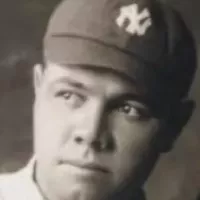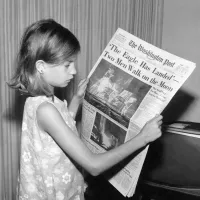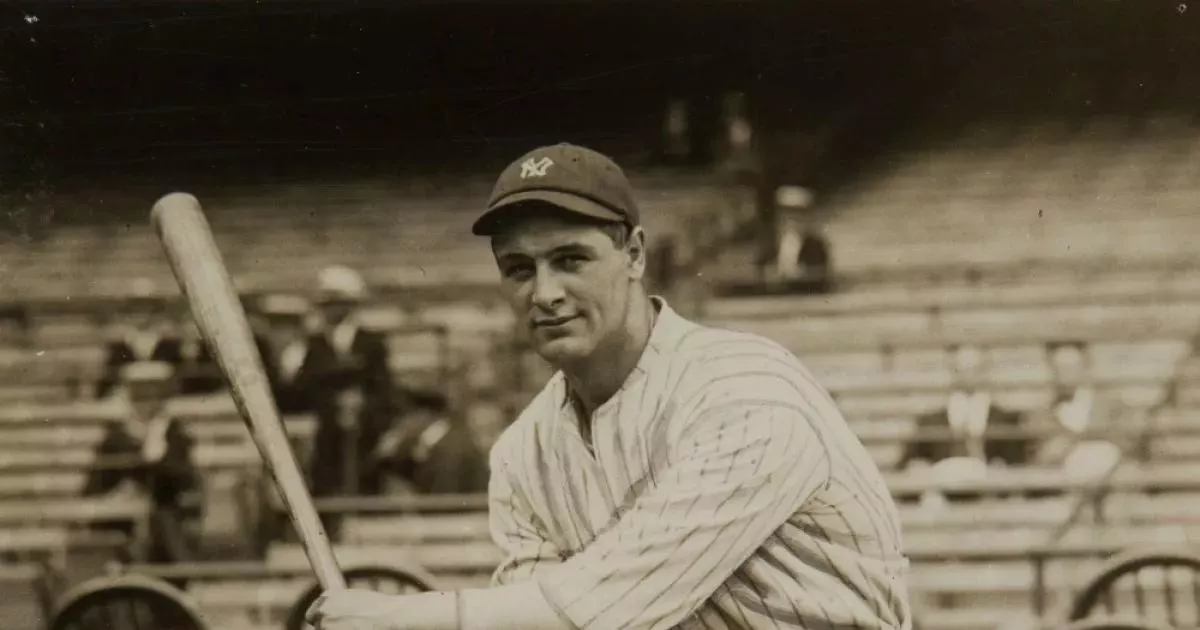Lou Gehrig, nicknamed "the Iron Horse," was a legendary New York Yankees first baseman (1923-1939) known for his hitting and durability. He achieved a .340 batting average, 493 home runs, and 1,995 RBIs. A seven-time All-Star, Triple Crown winner, and two-time AL MVP, he contributed to six World Series championships. His consecutive games played record stood for 56 years. Tragically, his career ended prematurely due to amyotrophic lateral sclerosis (ALS), now known as Lou Gehrig's disease. He was elected to the Baseball Hall of Fame in 1939, and the Yankees retired his number 4, a first in MLB.
June 19, 1903: Lou Gehrig Born
On June 19, 1903, Henry Louis Gehrig, also known as Heinrich Ludwig Gehrig, was born. He later became a celebrated baseball player for the New York Yankees.
June 26, 1920: Grand Slam at Cubs Park
On June 26, 1920, Lou Gehrig garnered national attention while playing baseball at Cubs Park (now Wrigley Field) in Chicago. Playing for Commerce High School, he hit a grand slam completely out of the major league park.
April 18, 1923: Gehrig strikes out 17 batters
On April 18, 1923, Columbia pitcher Lou Gehrig struck out 17 Williams Ephs batters, setting a team record. The same day Yankee Stadium opened and Babe Ruth hit a home run. Yankees scout Paul Krichell attended and was impressed with Gehrig's powerful left-handed hitting.
April 29, 1923: Signed with the Yankees
On April 29, 1923, Lou Gehrig, who was a student at Columbia University, signed with the New York Yankees.
June 15, 1923: Major League Debut
On June 15, 1923, Lou Gehrig made his major-league debut as a pinch hitter, marking the beginning of his career with the New York Yankees.
June 1, 1925: Gehrig replaces Pipp in lineup
On June 1, 1925, Lou Gehrig replaced Wally Pipp in the Yankees' lineup after Pipp took himself out of the game due to a headache. Gehrig went on to play in every game until April 30, 1939.
1930: Gehrig's High Batting Average
In 1930, Lou Gehrig had a high batting average of .379.
1930: Gehrig's Productive Season
In 1930, Lou Gehrig had one of his most productive seasons, contributing to a three-season stretch (1930-1932) where he recorded 509 RBIs.
1931: Gehrig's AL Record for RBIs
In 1931, Lou Gehrig recorded 185 RBIs, which remains the AL record as of 2025.
1932: Met Eleanor Twitchell
In 1932, Lou Gehrig met Eleanor Twitchell, who later became his wife.
1932: Monument Placed to Huggins
In 1932, a monument was placed at Yankee Stadium to Miller Huggins.
August 17, 1933: Breaks Consecutive Game Record
On August 17, 1933, Lou Gehrig played in his 1,308th consecutive game against the St. Louis Browns, surpassing Everett Scott's record for the longest consecutive games played streak. Scott was present as a guest of the Browns.
1933: Met Eleanor Twitchell
In 1933, Lou Gehrig met Eleanor Twitchell and began dating the next year. He also lived with his parents until 1933, when he was 30 years old.
April 30, 1934: 300th Home Run
On April 30, 1934, Lou Gehrig hit his 300th home run versus the Washington Senators, becoming the second player to reach this milestone after Babe Ruth. He also won the AL Triple Crown in 1934.
1934: Gehrig Hits More Home Runs Than Ruth
In 1934, Lou Gehrig hit 49 home runs compared to Babe Ruth's 22.
1935: Ruth Plays Handful of Games Before Retiring
In 1935, Babe Ruth played a handful of games before retiring.
1936: Time Magazine Article and Tarzan Audition
In 1936, Time magazine featured Gehrig and Carl Hubbell, calling Gehrig "the game's No. 1 batsman". Also in 1936, Gehrig auditioned for the role of Tarzan in Tarzan's Revenge but did not get the part.
1937: ALS Research
Researchers analyzed Rawhide and photographs of Gehrig from the 1937-1939 period, to ascertain when he began to show visible symptoms of ALS.
January 1938: Gehrig Stars in "Rawhide"
In January 1938, Lou Gehrig starred in the 20th Century Fox movie "Rawhide," playing himself in his only feature-film appearance.
September 27, 1938: Gehrig Hits Last Home Run
On September 27, 1938, Lou Gehrig hit his last home run.
April 30, 1939: Gehrig's Consecutive Game Streak Ends
Lou Gehrig's consecutive game streak came to an end on April 30, 1939. This was after 2,130 consecutive games played since June 1, 1925.
May 2, 1939: End of Consecutive Game Streak
On May 2, 1939, Lou Gehrig voluntarily took himself out of the lineup, ending his consecutive game streak. This decision was due to an undiagnosed ailment that was later confirmed to be amyotrophic lateral sclerosis (ALS).
June 13, 1939: Gehrig Arrives at Mayo Clinic
On June 13, 1939, Lou Gehrig flew to the Mayo Clinic in Rochester from Chicago, where the Yankees were playing. He underwent extensive testing to determine the cause of his physical decline.
June 19, 1939: ALS Diagnosis Released to Public
On June 19, 1939, the staff at the Mayo Clinic released Lou Gehrig's ALS diagnosis to the public.
October 1939: Gehrig Accepts Appointment as NYC Parole Commissioner
In October 1939, Lou Gehrig accepted Mayor La Guardia's appointment to a ten-year term as a New York City parole commissioner.
December 7, 1939: Gehrig Elected to Baseball Hall of Fame
On December 7, 1939, Lou Gehrig was elected to the Baseball Hall of Fame in a special election related to his illness. He was the youngest player to be so honored at the time.
1939: ALS Research on Gehrig
Researchers analyzed Rawhide and photographs of Gehrig from the 1937-1939 period, to ascertain when he began to show visible symptoms of ALS.
January 2, 1940: Gehrig Sworn in as NYC Parole Commissioner
On January 2, 1940, Lou Gehrig was sworn into office as a New York City parole commissioner, a position to which he was appointed by Mayor La Guardia in October 1939.
June 2, 1941: Lou Gehrig Death
On June 2, 1941, Lou Gehrig, the renowned baseball player, passed away.
July 6, 1941: Monument Dedicated to Gehrig at Yankee Stadium
On July 6, 1941, the Yankees dedicated a monument to Lou Gehrig in center field at Yankee Stadium, praising him as a great ballplayer and gentleman.
1942: Release of "The Pride of the Yankees"
In 1942, the film "The Pride of the Yankees", starring Gary Cooper as Lou Gehrig and Teresa Wright as his wife Eleanor, was released. It received 11 Academy Award nominations and won for Film Editing. Yankee teammates Babe Ruth, Bob Meusel, Mark Koenig, and Bill Dickey played themselves, as did sportscaster Bill Stern.
1955: Lou Gehrig Memorial Award First Presented
In 1955, the Lou Gehrig Memorial Award was first presented to an MLB player who best exhibits Gehrig's character and integrity, off and on the field.
April 19, 1956: "The Lou Gehrig Story" on CBS's Climax!
On April 19, 1956, "The Lou Gehrig Story," a television episode about the days leading up to his farewell speech, was featured on the CBS anthology TV series Climax!, starring Wendell Corey and Jean Hagen.
1972: Koufax Surpasses Gehrig
In 1972, Sandy Koufax surpassed Lou Gehrig as the youngest player elected to the Baseball Hall of Fame.
1976: Publication of "My Luke and I"
In 1976, Eleanor Gehrig and Joseph Durso co-authored "My Luke and I", an autobiography that chronicles the life of Eleanor and Lou Gehrig.
1978: Release of "A Love Affair: The Eleanor and Lou Gehrig Story"
In 1978, the TV movie "A Love Affair: The Eleanor and Lou Gehrig Story" was released, starring Blythe Danner and Edward Herrmann as Eleanor and Lou Gehrig, respectively. It was based on the 1976 autobiography "My Luke and I" written by Eleanor Gehrig and Joseph Durso.
March 6, 1984: Eleanor Gehrig's Death
On March 6, 1984, Eleanor Gehrig, Lou Gehrig's wife, died on her 80th birthday and was interred with him in Kensico Cemetery. She never remarried and dedicated her life to ALS research.
1994: Gehrig's Birthplace Memorialized
In 1994, Lou Gehrig's birthplace in Manhattan was memorialized with a plaque marking the site.
September 6, 1995: Cal Ripken Jr. Surpasses Gehrig's Consecutive Games Record
On September 6, 1995, Baltimore Orioles shortstop Cal Ripken Jr. surpassed Lou Gehrig's record of 2,130 consecutive games, a record that had stood for fifty-six years. Ripken ultimately finished with 2,632 consecutive games.
1999: Gehrig Receives Most Votes on All-Century Team
In 1999, Lou Gehrig received the most votes of any baseball player on the Major League Baseball All-Century Team, chosen by fan balloting, sixty years after his farewell to baseball.
1999: Gehrig Ranked Sixth Greatest Player by Sporting News
In 1999, editors at Sporting News ranked Lou Gehrig sixth on their list of "Baseball's 100 Greatest Players".
2004: Gehrig Featured in All Star Baseball 2004
In 2004, Lou Gehrig's digital likeness and the opening quote of his "baseball's Gettysburg Address" were featured in the video game All Star Baseball 2004.
2006: Rawhide Analysis
In 2006, researchers presented a paper to the American Academy of Neurology, reporting on an analysis of the movie "Rawhide" and photographs of Lou Gehrig from the 1937-1939 period to ascertain when he began to show visible symptoms of ALS.
2008: "The Pride of the Yankees" Honored by AFI
In 2008, the American Film Institute (AFI) honored "The Pride of the Yankees" as the third-best sports movie.
2010: Alex Rodriguez Ties Gehrig's Record
In 2010, Alex Rodriguez tied Lou Gehrig's major-league record of 13 consecutive seasons with 100 or more RBIs.
July 28, 2013: Special Tribute for Gehrig at Hall of Fame
On July 28, 2013, Lou Gehrig and 11 other deceased ballplayers received a special tribute during the induction ceremony held during "Hall of Fame Induction Weekend" in Cooperstown, New York.
March 2021: MLB Declares Lou Gehrig Day
In March 2021, Major League Baseball declared June 2 to be Lou Gehrig Day, commemorating his anniversary of becoming the Yankees' starting first baseman in 1925 and his death in 1941.
2022: Gehrig Named on New York Mount Rushmore of Sports
In 2022, as part of their SN Rushmore project, Sporting News named Lou Gehrig on their "New York Mount Rushmore of Sports", along with Babe Ruth, Walt Frazier, and Lawrence Taylor.
2025: Gehrig's 1931 Record Still Stands
As of 2025, Lou Gehrig's 185 RBIs recorded in 1931 still remains the AL record.
Mentioned in this timeline

Babe Ruth nicknamed the Bambino and the Sultan of Swat...
CBS Broadcasting Inc CBS is a prominent American commercial broadcast...

News encompasses information about current events disseminated through various media...

Football is a family of team sports primarily involving kicking...

Mount Rushmore National Memorial located in the Black Hills of...

Chicago is the most populous city in Illinois and the...
Trending

3 months ago Seth Rogen's 'Platonic' success and Chris Evans's audition fail stories revealed.
25 days ago Marty Supreme, Avatar, and Timothée Chalamet among December's most anticipated movie releases.

28 days ago Kayce Dutton's Journey: 'Y: Marshals' Trailer Reveals New Beginnings After 'Yellowstone'

Philip Edward Hartman was a multi-talented Canadian-American artist Born in Brantford Ontario he made a significant impact on American comedy...
Bolivia a landlocked country in central South America boasts diverse geography including Amazonian plains tropical lowlands mountains and Andean plateaus...
1 month ago Aruba: A Warm Caribbean Paradise Ideal for Slow Travel and Wellness Getaways
Popular

XXXTentacion born Jahseh Dwayne Ricardo Onfroy was a controversial yet...

Ben Shapiro is a prominent American conservative political commentator media...

Tucker Carlson is an American conservative political commentator known for...

Candace Owens is an American conservative political commentator and author...

William Franklin Graham III commonly known as Franklin Graham is...
The Kennedy Center Honors are annual awards recognizing individuals and...

